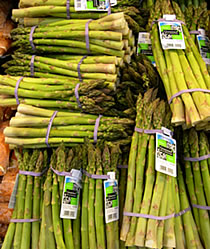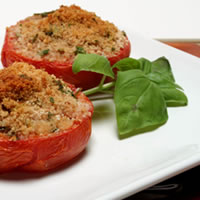Before refrigerated trucks and jet planes, asparagus was a springtime treat. While asparagus is now available nearly year-round, it still seems to taste best in the spring.
The delicate green color of farm-grown asparagus matches the spring leaves on plants and flowers. It's easy to make, delicious to eat, high in vitamins A, B and C, and a source of iron and potassium.
Asparagus has been a prized food since ancient times. The Greeks ate wild asparagus and the Romans cultivated it in their gardens, but asparagus did not become a big crop in North America until the end of the 19th century.
Producing crops of asparagus takes time and patience. No asparagus is produced for the first two years after seeds are sown. In the third year, the stalks are ready to eat, but the field produces good asparagus for only a few seasons, and then the quality deteriorates.
All of this makes asparagus more expensive than other green vegetables. April is the peak month for asparagus, so prices should be lower and quality high.
Early, pencil-thin asparagus has a slight purple tinge at the tip and is extremely tender.
In Europe, white asparagus is popular, which is grown underground, so it doesn't turn green. White asparagus spears are usually thicker and smoother than their green cousins.
Shop for firm, smooth, bright green stalks with tight tips. Wrinkled spears are dried out.
Asparagus is often sold in bundles bound with rubber bands. Take the bands off before storing; they make the spears sweat and spoil more quickly. Since they are grown in sandy soil, rinse the tips well.
Asparagus can be kept for three or four days refrigerated. Trim the stems and store asparagus standing upright, like flowers, in a tall glass with about an inch of water, loosely covered with a plastic bag.
Before cooking, trim spears by bending stalks until they break off, usually at the woody, inedible part of the spears. Use stalks of a uniform size so they cook evenly. Asparagus can be served as an appetizer, a soup, a side dish, or as part of a salad, as in this dish.
Marinated Asparagus, Tomato and Hearts of Palm
Servings: 6
Recipe Source: New American Heart Association Cookbook
Ingredients
- 8 ounces fresh asparagus, trimmed, cut into 2-inch pieces (about 2 cups)
- 1 pound Italian plum tomatoes, cut into 1/4-inch slices
- 14-ounce can hearts of palm, rinsed and drained
- 1/4 cup thinly sliced yellow onion
Dressing Ingredients:
- 1/4 cup red wine vinegar
- 2 tablespoons dry red wine (regular or nonalcoholic)
- 2 teaspoons sugar or sugar substitute
- 1/4 teaspoon pepper
Directions
- Steam asparagus for 3 minutes, or until tender-crisp. Immediately put asparagus in a shallow glass baking dish.
- Add a layer of tomatoes, then one of hearts of palm, and one of onion. In a small bowl, whisk together dressing ingredients until sugar has dissolved. Pour over vegetables.
- Cover dish and refrigerate for 30 minutes, stirring occasionally.
Nutritional Information Per Serving:
Calories: 57;
Protein: 3 g;
Sodium: 181 mg
Fat: 1 g;
Carbohydrates: 10 g
Diabetic Exchanges: 1 Vegetable
AICR











